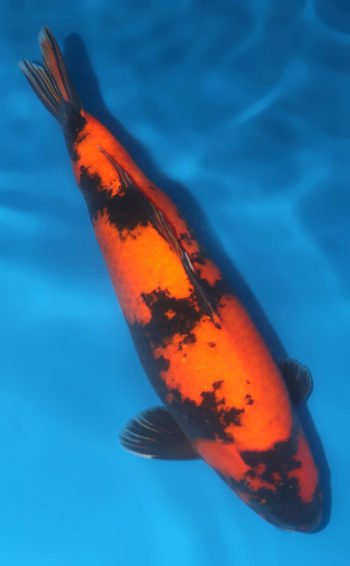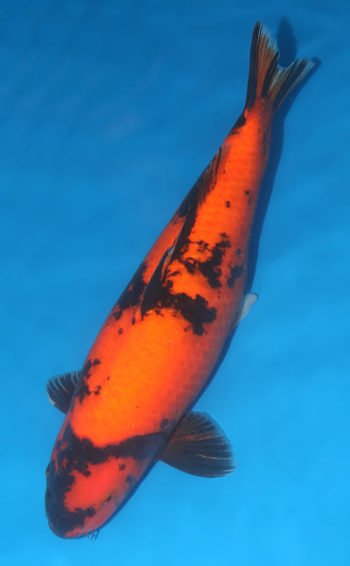Hi Utsuri Koi Female
See all of our high-quality koi fish for sale & butterfly koi fish for sale. We offer the very best selection of koi for sale in the industry. Put that alongside of our incredible 14-Day Live Arrival Guarantee, and the ability to choose your own delivery date and you have an unbeatable value.
14-DAY WORRY-FREE GUARANTEE: We offer an industry-leading 14-Day Worry-Free Guarantee to ensure that you can shop with peace of mind, knowing that you will always be covered.
Breeder(s): Arowana Paradise Farm
Sex: Female
Size: 22.05 inch
Variety: Hi Utsuri, Hiutsuri, Utsurimono
$300.00 Original price was: $300.00.$250.00Current price is: $250.00.
Description
Hi Utsuri Koi Female
Hi Utsuri Koi Female, Utsurimono are derived from the same lineage as Showa Sanshoku. They too have black skin, and are divided according to the color of interlacing markings into “Shiro Utsuri (contrasted by white markings),” “Hi Utsuri (contrasted by red markings)” and “Ki Utsuri (contrasted by yellow markings).”
Like in Showa Sanshoku, Sumi of Shiro Utsuri should essentially covers the nose, side faces (‘Menware’ for diverging head pattern) and pectoral fin joints (‘Motoguro’ for black base).Hi Utsuri and Ki Utsuri have red and yellow markings respectively in place of white ones on Shiro Utsuri. The body of Hi Utsuri and Ki Utsuri has the same Sumi as Shiro Utsuri, but their pectoral fins do not show Motoguro, but are striped instead. Formerly Utsurimono were produced mostly as by-products of Showa Sanshoku breeding. Recently, however, very high quality Utsurimono have been bred with excellent Shiro Utsuri on one or both sides of parentage. Hi Utsuri continue to be born as the by-products of Showa Sanshoku breeding. However, we have seen very little of Ki Utsuri lately.
Utsuri is another very popular koi fish for Japanese koi ponds and water gardens. When you search for quality koi for sale, look for Utsuri koi that have pleasing checkerboard patterns and clear defined colors. Utsurimono have black skin, and are divided by interlacing markings of one other color. It has black bands of color wrapping around the body with one other non-metallic color. A red Utsuri is called Hi Utsuri, white type is called Shiro Utsuri, and the yellow type is called Ki Utsuri. Hi Utsuri and Ki Utsuri have red and yellow markings respectively in place of the white areas on a Shiro Utsuri. The sumi should be dark and distinct on the koi regardless of the contrasting color.
Like the Showa variety, sumi (black) on an Utsuri should essentially appear as bands of color on the nose, face side and throughout the body, as well as in the pectoral fin joints. Motogoro is the term for the black pigment located on the pectoral fins. Menware is the term referring to a band of sumi which divides the face or head pattern on the koi. The pectoral fins of Hi Utsuri and Ki Utsuri do not show Motoguro in the pectoral joints, instead, they are striped with sumi.
Formerly, Utsurimono were produced mostly as by-products of Showa Sanshoku breeding. Recently, however, very high quality Utsurimono has been bred with excellent Shiro Utsuri on one or both sides of parentage. Hi Utsuri koi continue to be born as a by-product of Showa Sanshoku koi breeding.
What to Look For When Selecting a Gin Rin Koi
When searching for a good Gin Rin koi you need to look past all the bling, if that’s possible, and pick a fish that is as close to perfect in every other dimension. First, check out the koi’s body conformation. See that it has correct proportions and all fins are intact. Next, watch how it swims, breathes, and reacts to other koi. Then pick out the fish with the most pleasing pattern or colors that you like.
Finally you can concentrate on the Gin Rin scales. Remember that a Gin Rin Koi should have two or more complete rows of scales, the more the better. They should start at the shoulder and end at the tail. Look for scales that are neatly organized in straight and even rows. Avoid those with missing, random or jumbled scales. The layout or placement of scales will not change as your new pet grows. And lastly, choose the koi with the best sparkle as Kin Gin Rin koi are also judged on the quality of their scales.
Koi Care Guide – Six things to know about your koi
- Experience Level: Intermediate
- Size: Koi grow up to 36 inches (91 cm) long
- Lifespan: They can live for more than 50 years and thrive in a wide range of water temperatures
- Temperament: They are generally peaceful but may pick on slower fish
- Origin: They’re a type of carp native to Japan
- Did You Know: Koi can learn to recognize and take food from their pet parents
How do I set up my koi’s aquarium?
- Koi grow quickly and get very large. Keep mature koi in an outdoor pond of at least 3 feet deep, with at least 50 gallons of water per fish.
- Young koi can be kept indoors in an aquarium of at least 29 gallons.
- Put the aquarium in a quiet area out of direct sunlight and drafts.
- Cover the aquarium with a hood to reduce evaporation and splashing and to keep fish from leaping out.
- To transfer new koi to the aquarium, float them in the water inside their bag for about 10 minutes so they can acclimate to the new water temperature.
- If you’re introducing koi to an existing school in an aquarium or pond, quarantine the new fish in a separate body of water for 2 to 4 weeks to be sure they are healthy.
- On moving day, use a net to transfer the koi so old water doesn’t mingle with new water.
- Whether they live indoors or outdoors, add no more than 3 new koi at a time.
Heat & light
Outdoor koi are hardy and will hibernate under ice in winter as long as their pond is deep enough to not freeze completely. (They won’t survive in solid ice.)
Your koi’s pond should be partially shaded.
Indoor koi prefer water between 65 and 75 degrees Fahrenheit.
Install a light inside an indoor aquarium to illuminate it for 8 to 12 hours a day.
Water temperature
Koi are pretty temperature-resistant— they can even hibernate under ice in winter. Just be sure your pond is at least three feet deep— otherwise, it could freeze solid, and koi aren’t that tough. When they live indoors, koi prefer cool water—between 65 and 75 degrees F (18 to 24 C).
How do I keep my koi healthy?
If your outdoor koi don’t seem to be eating in the winter, don’t worry; it’s normal for them to stop eating at temperatures below 40 F. Be sure to contact a veterinarian if you notice any of these symptoms:
- Unusual swimming pattern
- Thinness or decreased appetite
- Abdominal swelling
- Inflamed or discolored skin or fins
- Fins clamped to sides of body
- Scraping body on rocks (flashing)
types of koi fish, koi fish, koi fish price, koi fish pond, koi fish meaning, koi fish for sale, koi fish drawing, koi fish care, koi fish for sale online, butterfly koi for sale, koi fish for sale near me, big koi for sale, buy koi fish cheap, koi fry for sale usa, types of koi fish, koi fish for sale, High Quality Koi, Coy fish, coe fish, ki utsuri koi, hi utsuri koi for sale, hi utsuri shinoda, hi utsuri koi price, hi utsuri koi meaning, shiro utsuri koi, ki utsuri koi for sale, hi utsuri butterfly koi





Reviews
There are no reviews yet.